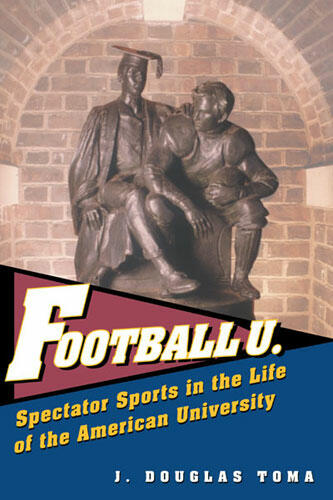Football U.
Spectator Sports in the Life of the American University
A balanced look at the use of athletic programs as a tool in "branding" universities and in building community spirit, support, and identity both on campus and off
Description
The Big Ten . . . the SEC . . . the Final Four . . . sometimes it seems that American higher education is more about sports than studies. Not so, says this well-researched, evenhanded study of athletics in university life. Sports--particularly football--play a key role in defining institutions that might otherwise be indistinguishable and are an indispensable tool in building a sense of community on campus, as well as an important factor in mustering alumni and political support.
While abuses exist, the "football school" is not only a legitimate member of the academic community but an inevitable one as well--and football provides much-needed identity at every level from the local to the national scale. Pointing out that universities compete as much academically as athletically, J. Douglas Toma argues that fielding a winning sports team is a quick, effective way to win recognition and that doing so pays dividends across the board, by raising public awareness (thereby making a school more attractive to potential students and faculty) and by creating a wider constituency of "fans" whose loyalties pay off in increased contributions and appropriations that support academic programs as well. He notes that universities like Harvard and Yale, now eclipsed on the gridiron, were "football powers" in the era when America's westward expansion spawned new schools unable to challenge older institutions academically but able to win acclaim through sports. This fosters a campus and alumni culture based on "football Saturday"--a bonding experience that helped forge a larger community whose support, both personal and financial, has become integral to the life of the institution.
Football U. brings welcome impartiality to a subject all too often riven by controversy, pitting football boosters against critics who complain that academic achievement takes second place to athletic success. But as a tool for creating "brand awareness" as well as local loyalty and widespread support, high-profile athletic programs meet a variety of institutional needs in ways no other aspect of university life can. This, Toma observes, is a two-edged sword, for even as it fosters collegiality, it discourages reform when the pendulum swings too far in the direction of athletic dominance. Nevertheless, Football U. is here to stay.
J. Douglas Toma is Director and Senior Fellow, The Executive Doctorate and Penn Center for Higher Education Management, the University of Pennsylvania's Graduate School of Education.
J. Douglas Toma is Associate Professor, Institute of Higher Education at the University of Georgia.
Reviews
"It is important to recognize what spectator sports have contributed to American higher education, and I enjoyed and learned from Doug Toma's reflections on these contributions in Football U. Kudos to Dr. Toma for reminding us of the significant benefits that spectator sport brings to sustaining a positive culture within and recognition outside our great American universities."
- David Longanecker, Executive Director of the Western Interstate Commission for H
—David Longanecker, Executive Director of the Western Interstate Commission for Higher Education
"In addition to telling an engaging story about sports in the academy, Toma demonstrates a way of integrating insights from several parts of our field of study and weaving a story that should be of broad interest, showing us that the field of higher education has something to say to the general public. He also provides a compelling portrait of the role of college sports in building universities. The payoff from investment in sports, we learn, may be in the memories of college football weekends, images that compel many to return to their towns on crisp fall Saturdays—sometimes even when their teams lose."
- Edward St. John, Univ of Michigan
—Edward St. John, University of Michigan
"Football U. perceptively illuminates the place of 'big-time' college athletics in major research universities. But make no mistake, this is a book about education, not sports. Its discussions of the context in which athletics operates—'collegiate life,' and the economics and cultures of major research universities—are required reading for anyone who wants to truly understand the rapidly changing nature of American higher education."
- Jeffrey Orleans, Executive Director, Council of Ivy Group Presidents
—Jeffrey Orleans, Executive Director, Council of Ivy Group Presidents
"Football U. offers insight into the foundation for institutional fervor, the challenges to sustain town, gown, alumni, and adoptee excitement and the fiscal and political pressures associated with these amazing enterprises."
- Larry Moneta, Ed.D, Vice President for Student Affairs, Duke University
—Larry Moneta, Ed.D, Vice President for Student Affairs, Duke University
"Football U. is a thorough and thought-provoking examination of the way a university's image is formed by football and other spectator sports. J. Douglas Toma deftly discloses how football helps universities connect with certain constituencies in a way academics alone cannot, and why expecting excellence from student-athletes on the field and in the classroom is a superior strategy for a successful university."
- Steven B. Sample, President, University of Southern California
—Steven B. Sample, President, University of Southern California
"[H]ighly readable . . . makes a compelling case that high-stakes football is a spectator sport whose purpose is institution-building, not student character-building as the conventional wisdom would have it. Toma does the academy a service by calling for more transparency about the purposes and imperatives of big-time athletics programs."
- William Massy, Professor Emeritus and former Vice President for Finance, Stanfor
—William Massy, Professor Emeritus and former Vice President for Finance, Stanford University
". . . brings impartiality to a subject all too often filled with controversy, pitting football boosters against critics who complain that academic achievement takes second place to athletics success."
- Athletics Administration
—Athletics Administration, October 2003

